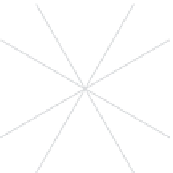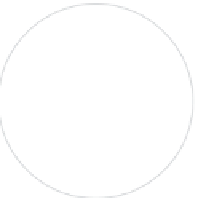Graphics Reference
In-Depth Information
section, then the azimuthal dependence reduces to the difference
φ
r
−
φ
i
of the
azimuthal angles
becomes an expression in-
volving two-parameter functions, which can be precomputed and stored in a 2D
table (i.e., a texture map).
The longitudinal functions
M
were fit to observations; the azimuthal functions
N
came from physical considerations. The
M
functions were found to be fairly
close to the Kajiya-Kay model, although the specular highlight is shifted by the
angle
φ
i
and
φ
r
. Therefore,
S
(
θ
i
,
θ
r
,
φ
i
,
φ
r
)
of the cuticle scaled as described previously. In the final model, the
M
functions are a Gaussian functions centered at the half-angle between the incident
and reflected directions, but shifted by a multiple of
α
according to the number
of reflection and refraction events involved. The
M
TT
and
M
TRT
lobes are shifted
towards the tip of the hair fiber, whereas the
M
R
is shifted toward the root.
Marschner and his colleagues were not the first to perform direct measure-
ments of reflection in hair fibers (this had been done years earlier in the context
of cosmetic science) but they were the first to perform full hemispherical mea-
surements of hair reflection. They also recorded a special set of measurements by
placing the light source and the camera at a fixed equal angle of incidence and
reflection, then rotated the camera 360
◦
. This results in a direct azimuthal mea-
α
10
10
10
θ
i
= 0º
60
θ
i
= 15º
60
θ
i
= 30º
60
30
30
30
f
f
f
1
1
1
0º
0º
0º
-30
-30
-30
-60
-60
-60
10
10
10
60
60
60
θ
i
= 45º
θ
i
= 60º
θ
i
= 75º
30
30
30
f
f
f
1
1
1
0º
0º
0º
-30
-30
-30
-60
-60
-60
Figure 8.54
Plots of azimuthal measurements. For each fixed incident direction θ
i
, a sensor is placed at
the specular direction and rotated around the fiber. The plots show the off-specular peaks
known as
glints
evolving toward the normal specular highlight as θ
i
increases.
(From
[Marschner et al. 03] c
2003 ACM, Inc. Included here by permission.)

































































